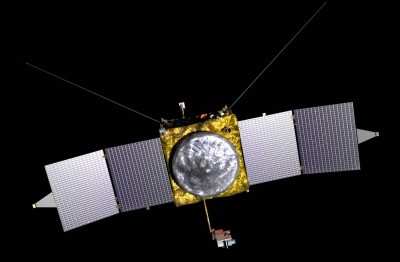MAVEN Greenlighted For A Targeted 2013 Launch
 NASA's mission to investigate the mystery of how Mars lost
much of its atmosphere passed a critical milestone on October 4,
2010. NASA has given approval for the development and 2013 launch
of the Mars Atmosphere and Volatile Evolution (MAVEN) mission.
NASA's mission to investigate the mystery of how Mars lost
much of its atmosphere passed a critical milestone on October 4,
2010. NASA has given approval for the development and 2013 launch
of the Mars Atmosphere and Volatile Evolution (MAVEN) mission.
Clues on the Martian surface, such as features resembling dry
riverbeds and minerals that only form in the presence of liquid
water, suggest that Mars once had a denser atmosphere, which
supported the presence of liquid water on the surface. As part of a
dramatic climate change, most of the Martian atmosphere was lost.
MAVEN will make definitive scientific measurements of present-day
atmospheric loss that will offer insight into the Red Planet's
history.
Michael Luther, on behalf of Dr. Ed Weiler, of the NASA
Headquarters Science Mission Directorate led a confirmation review
panel that approved the detailed plans, instrument suite, budget,
and risk factor analysis for the spacecraft.
"A better understanding of the upper atmosphere and the role
that escape to space has played is required to plug a major hole in
our understanding of Mars. We're really excited about having the
opportunity to address these fundamental science questions," said
MAVEN Principal Investigator Dr. Bruce Jakosky of the Laboratory
for Atmospheric and Space Physics at the University of Colorado
(CU-LASP) at Boulder.

NASA MAVEN Artist's Rendering
"The team has successfully met every major milestone since
selection two years ago," said MAVEN Project Manager David Mitchell
of NASA's Goddard Space Flight Center, Greenbelt, Md. "Looking
forward, we are well positioned for the next push to critical
design review in July 2011. In three short years, we'll be heading
to Mars!"
The confirmation review, formally known as "Key Decision Point
C," authorized continuation of the project into the development
phase and set its cost and schedule. The next major mission
milestone, the critical design review, will examine the detailed
MAVEN system design. After a successful critical design review, the
project team will assemble the spacecraft and its instruments.

Mars' Atmonphere NASA Image
"This project is a vital complement to past, present, and future
Mars missions," said Dr. Michael Meyer, lead Mars Scientist for
NASA's Mars Exploration Program in Washington. "MAVEN will take us
a step closer in learning about the evolution of our intriguing
celestial neighbor."
NASA Goddard will manage the project, which will cost $438
million excluding the separately government-furnished launch
vehicle and telecommunications relay package. Goddard will also
build some of the instruments for the mission. In addition to the
PI coming from CU-LASP, the university will provide science
operations, build instruments, and lead Education/Public Outreach.
Lockheed Martin of Littleton, Colo., will build the spacecraft
based on designs from NASA's Mars Reconnaissance Orbiter and 2001
Mars Odyssey missions and perform mission operations. The
University of California-Berkeley Space Sciences Laboratory will
also build instruments for the mission. NASA's Jet Propulsion
Laboratory, Pasadena, CA, will provide navigation support, the Deep
Space Network, and the Electra telecommunications relay hardware
and operations.
 Airborne-NextGen 11.04.25: Anduril YFQ-44A, Merlin SOI 2, UAV Rulemaking Stalled
Airborne-NextGen 11.04.25: Anduril YFQ-44A, Merlin SOI 2, UAV Rulemaking Stalled NTSB Prelim: Elmore Travis C Searey
NTSB Prelim: Elmore Travis C Searey ANN's Daily Aero-Linx (11.03.25)
ANN's Daily Aero-Linx (11.03.25) ANN's Daily Aero-Term (11.03.25): On-Course Indication
ANN's Daily Aero-Term (11.03.25): On-Course Indication Aero-News: Quote of the Day (11.03.25)
Aero-News: Quote of the Day (11.03.25)





